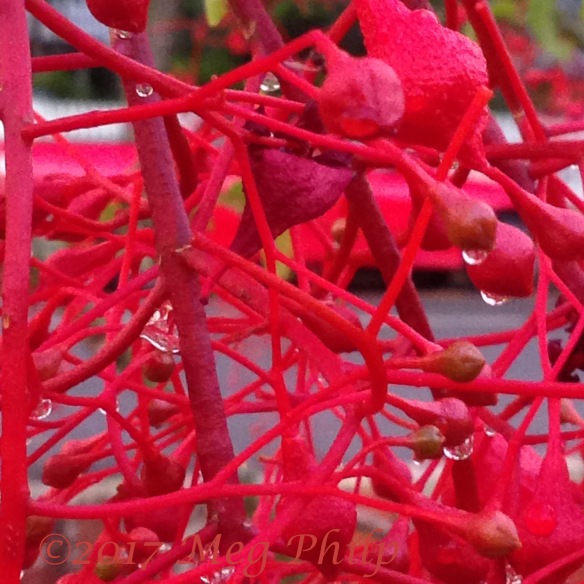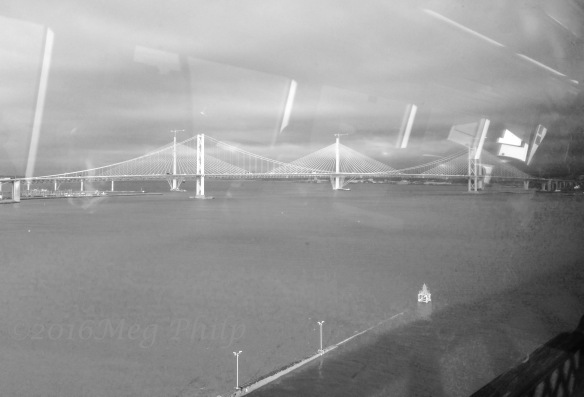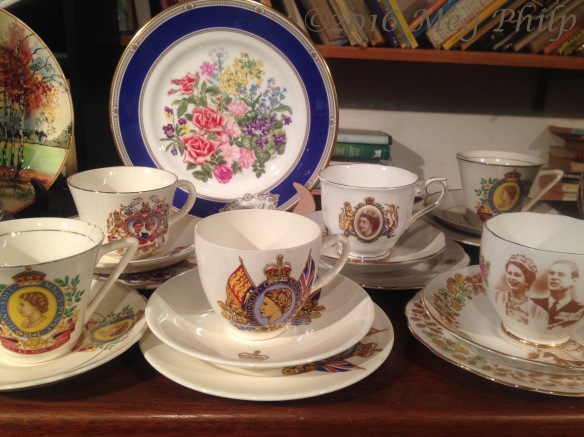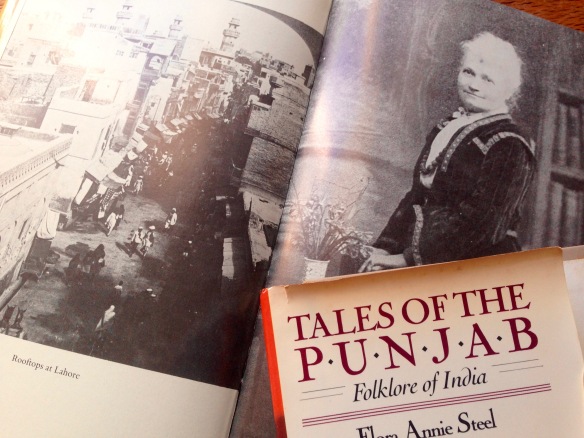This week’s Photo Challenge gave me too much choice. I scrolled thru my photos and mulled over my choices for a while. ‘Good’ is such a loaded word.
The colour of my neighbour’s ‘Tilly’ (Utility Truck) is pretty close to the blossoms on my Illawarra Flame Tree. Reds are hard to match.

Last year I was keen to get a photo from the train going over my favourite railway bridge.
These two road bridges across the river Forth seem to make an agreeable match. The new one, farthest west, is called Queensferry Crossing and isn’t scheduled to be operational till May 2017.

And there’s nothing nicer than having restorative tea ( and maybe, a little cake?) from a matching cup, saucer and plate. Do you have a ‘special’ cup and saucer? I spotted these in a second-hand store.
 I spy a few ‘matches’ here.
I spy a few ‘matches’ here.
Marriage is a different kind of ‘match’ – as unique as the people involved.
…
Flora Annie Webster accepted Henry Steel’s proposal made by mail and married on New Year’s Eve 1867.The couple sailed for India the following morning. Henry Steel ‘Hal’ had been a friend of her brothers’ and was newly appointed Chief Magistrate for the Indian Civil Service in the Punjab. Flora had had no formal education. While her 8 brothers all went to Harrow School, Flora read her way thru her father’s eclectic library.
As a 22yr old, she insisted she accompany Hal to the remote villages where he conducted hearings. Other Anglo wives were shocked to see her riding, wearing trousers. Amongst other things like swimming, she learned Punjabi and began to write down the stories she heard told to the village children who gathered to inspect the newcomers. The first of the 30 books she went on to write was a collection of folktales (published in 1894).
Flora said this of her marriage –
Why I married I cannot say: I have never been able to say. I don’t think either one of us was in love. I know I was not. I never have been.

I’ve been re-reading Flora’s fascinating biography by Violet Powell so as to tell some of her life story as part of upcoming International Women’s Day celebrations. Hopefully, I do her justice because …
She was an ‘unconventional memsahib,’ a human dynamo who put her energy into the welfare and education of the people in her husband’s district and beyond: an individual who was bold in her battles with the Indian Government when she thought its actions were unjust and unwise. After her success teaching English, she was invited to establish a girl’s school and was later appointed as the first Inspector of Schools throughout the Punjab.
She uncovered a corruption scandal in the university there. When her husband was suddenly given a remote posting, Flora refused to go. The girls’ school had 400 students! Hal left behind yet another garden ( He was an avid gardener.) and set off north. On arrival, he received an official letter asking him why he hadn’t made his wife comply (and get out of their way, I’d say). His message by return was “You take her for a month and try.”
She lived alone in Lahore for a year then, despite several assassination threats, till the corruption she’d uncovered was proven and her claims vindicated. When Hal finally ended his term of duty in 1889 (after 15 transfers in 16 years) and they were leaving for England, she was farewelled at the railway station by 300 veiled women.
Home in England, Flora began to write in earnest and continued to be involved in many social issues. She did return to India alone to research what turned out to be her definitive novel about the Sepoy Rebellion of 1857-58. Considered ‘Kipling’s only serious rival’, she called herself a ‘vehement suffragette’ and was President of the Women Writers Suffrage League at one stage. Some think her a contradictory woman of her (Victorian) time – she always stressed that there be co-operation between men and women – a good match: a partnership.
References
COPPIN, Liesbeth. The British-Indian experience: Flora Annie Steel as an unconventional ‘memsahib.‘ Masters Thesis. Ghent University, June 2010.
POWELL, Violet (1981) Flora Annie Steel: Novelist of India. London, Heinemann.
STEEL, Flora Annie (1983 ) Tales of the Punjab: Folklore of India. New York, Greenwich House.
… (1897) On the Face of the Waters: a Tale of Mutiny. London, Heinemann.
(Titles are still available for purchase online)
Text and photos by Meg
Story Twigs the Imagination! by Meg Philp is licensed under a Creative Commons Attribution-Non Commercial-ShareAlike 4.0 International License.


Thanks for sharing an inspirational life story! Matching passion and work can do tremendous amounts of Good!
LikeLike
Thanks Scilla. She was really practical. The medical books she’d read meant she could help local women and their children. Thanks for you succinct summary, dear reader. M
LikeLiked by 1 person
Fabulous post, Meg. Thank you.
LikeLike
She was a real ‘can do’ kind of person. She painted, organised theatrical soirees and made her own clothes as well! I’m reminded of a mutual friend of ours … Thanks for reading my post. 😊
LikeLike
well researched. Are you learning any of her stories?
LikeLike
Hi Ffran. I have told the ‘Close Alliance.’ And I’ve heard The Barber’s Clever Wife a few times. Have you? Am looking for another shorter one. Good to hear from you.
LikeLike
How wonderful to hear of Flora Steel.What a woman! I’d love to read more about her.
LikeLike
Glad you liked the post, Pam. You can borrow the biography, if you like. Half of it goes into a rundown of the books she wrote. I was engrossed! M
LikeLike
A great and inspiring post and I love to drive over the river Forth on my,sadly, all too rare trips to Scotland. x
LikeLike
Thank you. Flora was quite a woman and lived for a time in Scotland! Yes it’s a beautiful country. I took lots of photos there and had a great holiday last year. S’funny how some of vistas are etched into the mind so clearly.
LikeLiked by 1 person
I love Edinburgh and the Dumfries and Galloway areas the best. Lots of favourite haunts. x
LikeLike
Yes. I couldn’t get over how green Galloway was … all those hilly little fields … and those white ‘belted’ black cows. 🙂
LikeLiked by 1 person
What a great post, Meg. Thank you for introducing me to an unconventional and admirable woman. It made me want to learn more about her.
LikeLike
Thanks Naomi. Just have to polish it a bit more for telling on Wednesday. 🙋
LikeLiked by 1 person